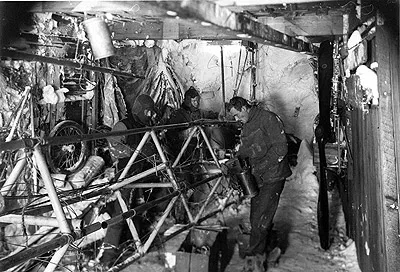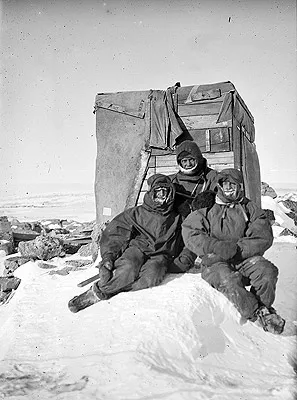Lt. Edward Frederick Robert Bage
Biographical notes
Astronomer, Assistant Magnetician & Recorder of Tides - Aurora 1911-1913

Single, a graduate in Engineering of Melbourne University
and a lieutenant in the Royal Australian Engineers. A member
of the Main Base Party (Adelie Land) and leader of the Southern
Sledging Party, he remained in the Antarctic for two years.
During the first year he was in charge of chronometers, astronomical
observations and tidal records, and throughout the second year
continued the magnetic work and looked after stores.
From
Appendix 1, Mawson - Heart of the Antarctic
Bage died in 1915 a casualty of WW1 at Gallipoli.
Landmarks named after Lt. R. Bage
Feature Name: Cape Bage
Feature Type: cape
Latitude: 67 43S
Longitude: 146 34E
Description:
A prominent point on the coast between Murphy Bay and Ainsworth
Bay. Discovered in 1912 by the AAE (1911-14) under Douglas Mawson.
References to Edward
Bage in Mawson's book "The Home of the Blizzard"
buy USA |
buy UK
-
During April the head of the boat harbour froze over permanently, the ice reaching a thickness of eighteen inches in ten days. By that time it was strong enough to be suitable for a tide-gauge. This was one of Bage's charges, destined to take him out for many months in fair and foul weather.
-
Despite contrary predictions, there were some enjoyable days in June. Occupation had to be strenuous, making the blood run hot, otherwise the wind was apt to be chill. So the Transit House was founded, and there were many volunteers to assist Bage in carrying the tons of stones which formed its permanent base.
-
A Southern Party composed of Bage (leader), Webb and Hurley. The special feature of their work was to be magnetic observations in the vicinity of the South Magnetic Pole.
-
This notice was to the effect that the non-arrival of the leader's party rendered it necessary to prepare for the establishment of a relief expedition at Winter Quarters and appointed Bage, Bickerton, Hodgeman, Jeffryes and McLean as members, under the command of Madigan; to remain in Antarctica for another year if necessary.
-
We set to work to make the Hut, if anything, safer and snugger. Bage put finishing touches to the break-wind of rock and cases, and with Hodgeman and McLean nailed battens of wood over a large sheet of canvas which had been stretched across the windward side of the roof, overlapping rolls of black paper, scraps of canvas and bagging, which were also battened down to make the eastern and western faces more air-tight.
-
Bage, following the parting instructions of Webb, became the owner of the Magnetograph House and the Absolute Hut, continuing to keep the magnetic records. As storeman, Bage looked after the food-supplies. The canvas coverings had made the veranda drift-tight, so the storeman could arrange his tins and cases on the shelves with some degree of comfort, and the daily task of shovelling out snow was now at an end. Further, Hodgeman and he built an annex out of spare timber to connect the entrance veranda with the store. This replaced the old snow-tunnel which had melted away, and, when completed and padded outside with old mattresses, was facetiously styled the "North-West Passage." The only thing which later arose to disturb the composure of the storeman was the admission of the dogs to a compartment in the veranda on the eastern side. His constant care then became a heap of mutton carcases which the dogs in passing or during the occasional escapades from their shelter were always eager to attack.
-
Cooking reached its acme, according to our standard, and each man became remarkable for some particular dish. Bage was the exponent of steam puddings of every variety...
-
Bage related how he had sailed across the Magnetic Flat by sitting down and raising his arms in the air. He was accompanied by Fix, Peary and George, who were blown along the slippery surface for yards. McLean had a "lively time" cutting ice and bringing in the big blocks. Often he would slide away with a large piece, and "pull up" on a snow patch twenty yards to leeward.
-
Meanwhile, it was suggested that if a heavy kite were made and induced to fly in the continuous winds, the aerial thus provided would be sufficient to receive wireless messages. To this end, Bage and Bickerton set to work, and the first invention was a Venesta-box kite which was tried in a steady seventy-mile wind. Despite its weight - at least ten pounds - the kite rose immediately, steadied by guys on either side, and then suddenly descended with a crash on to the glacier ice. After the third fall the kite was too battered to be of any further use. Another device, in which an empty carbide tin was employed, and still another, making use of an old propeller, shared the same fate.
Biographical information
- I am concentrating on the Polar experiences of the men involved.
Any further information or pictures visitors may have will be gratefully received.
Please email
- Paul Ward, webmaster.
What are the chances that my ancestor was an unsung part of the Heroic Age
of Antarctic Exploration?




